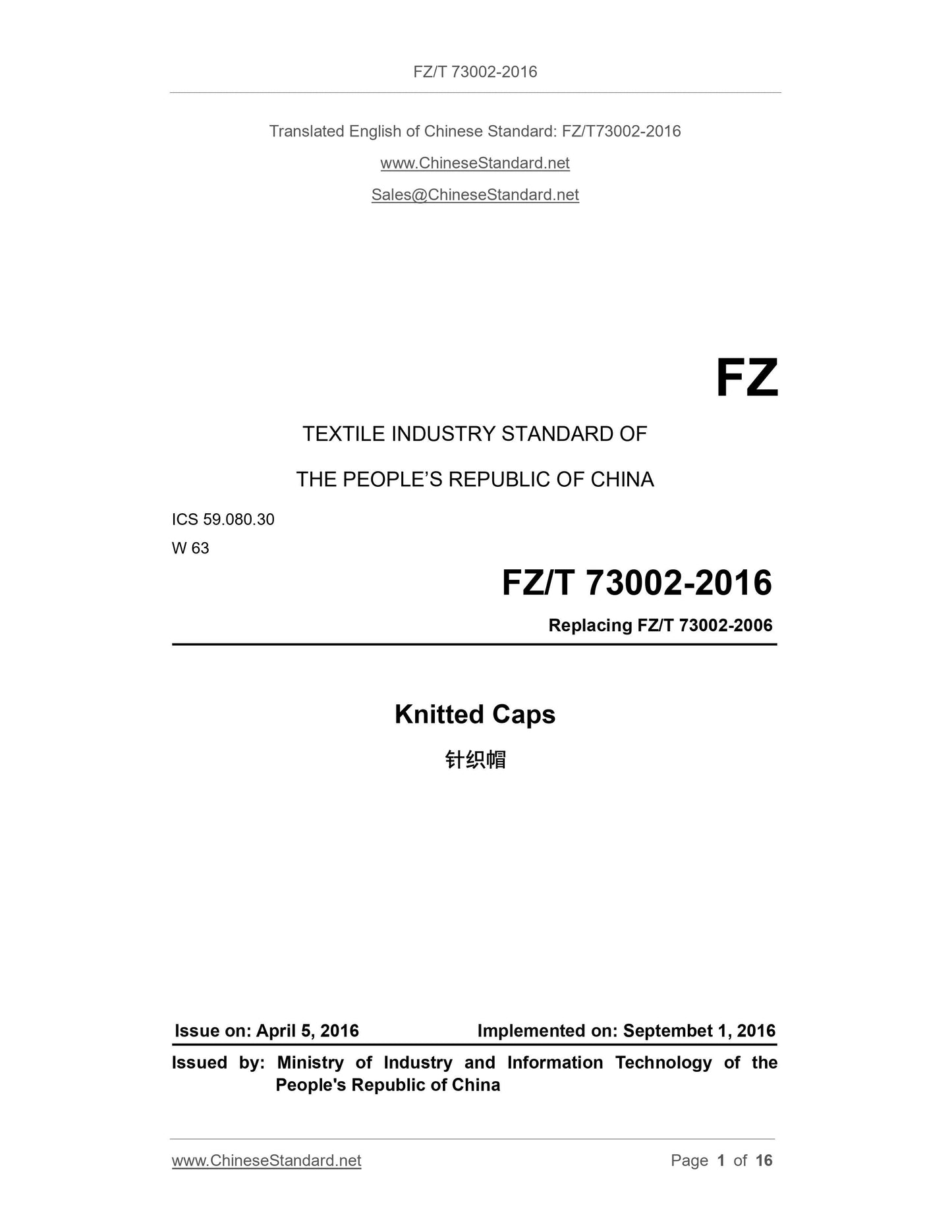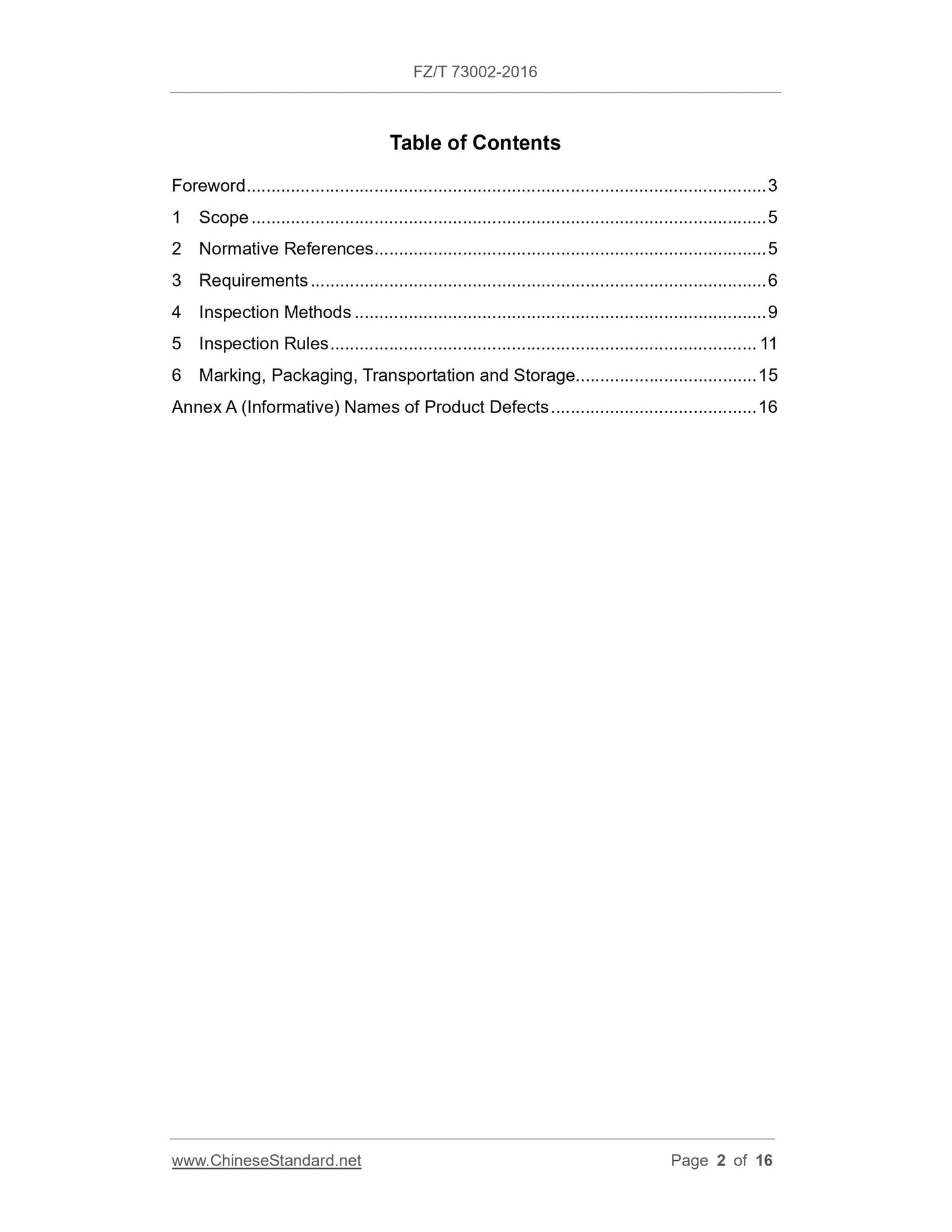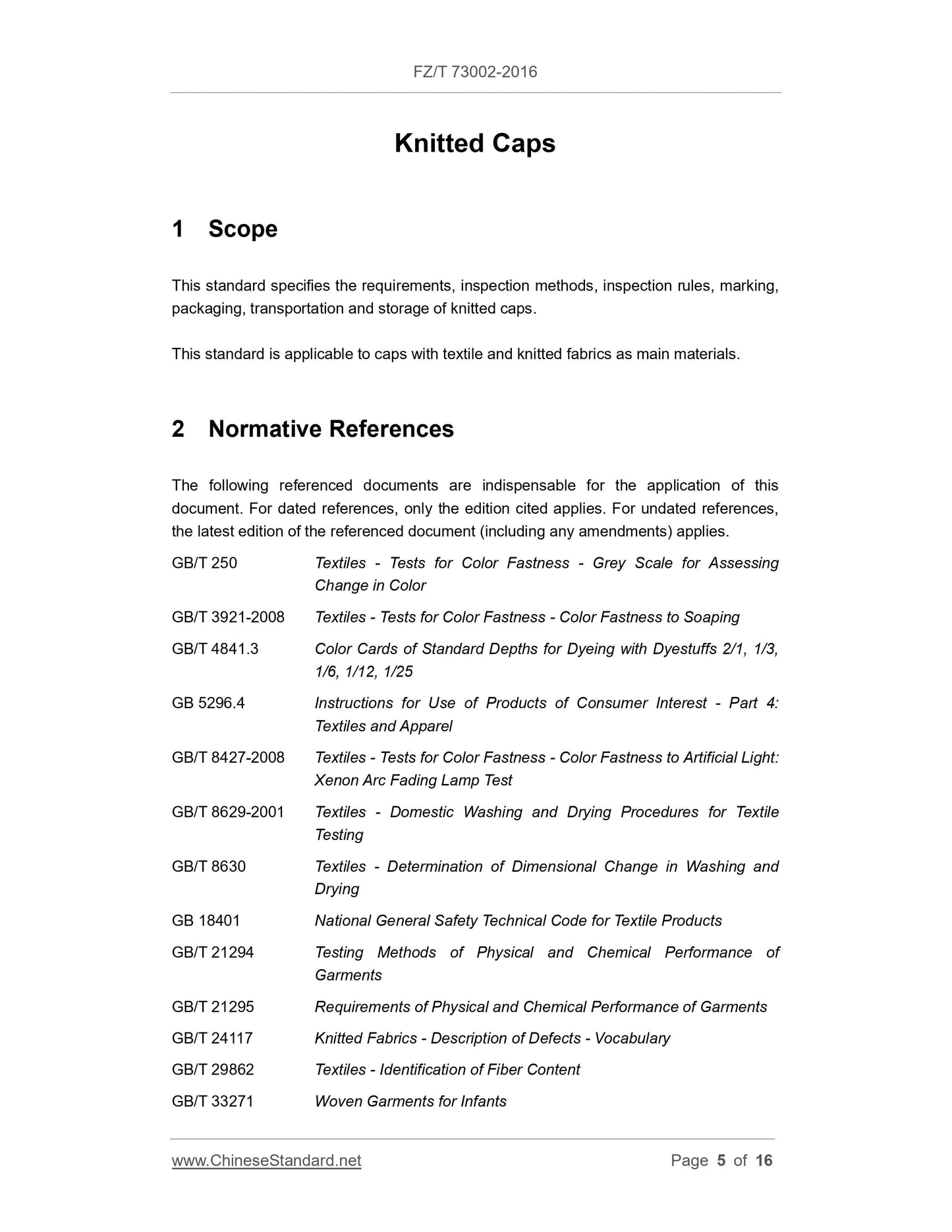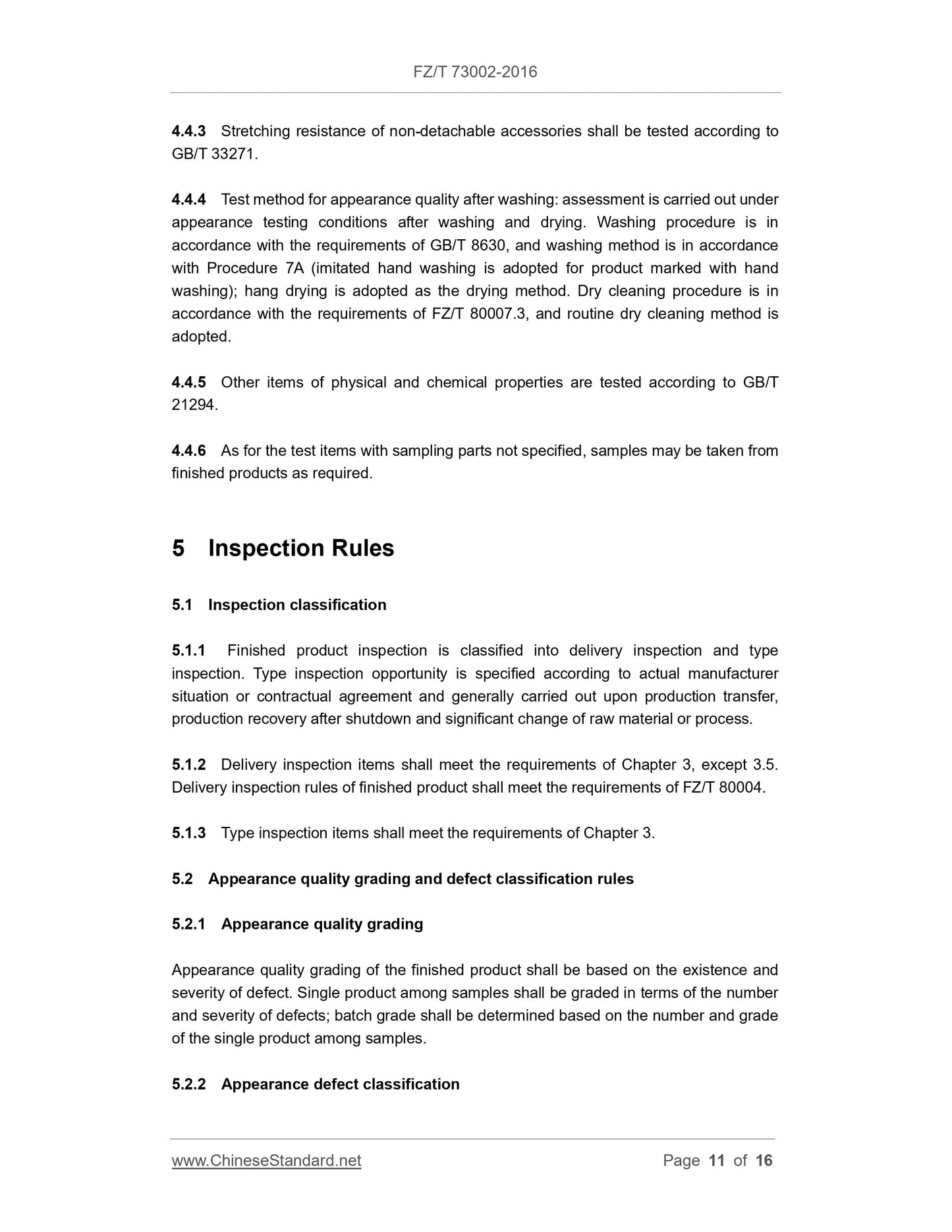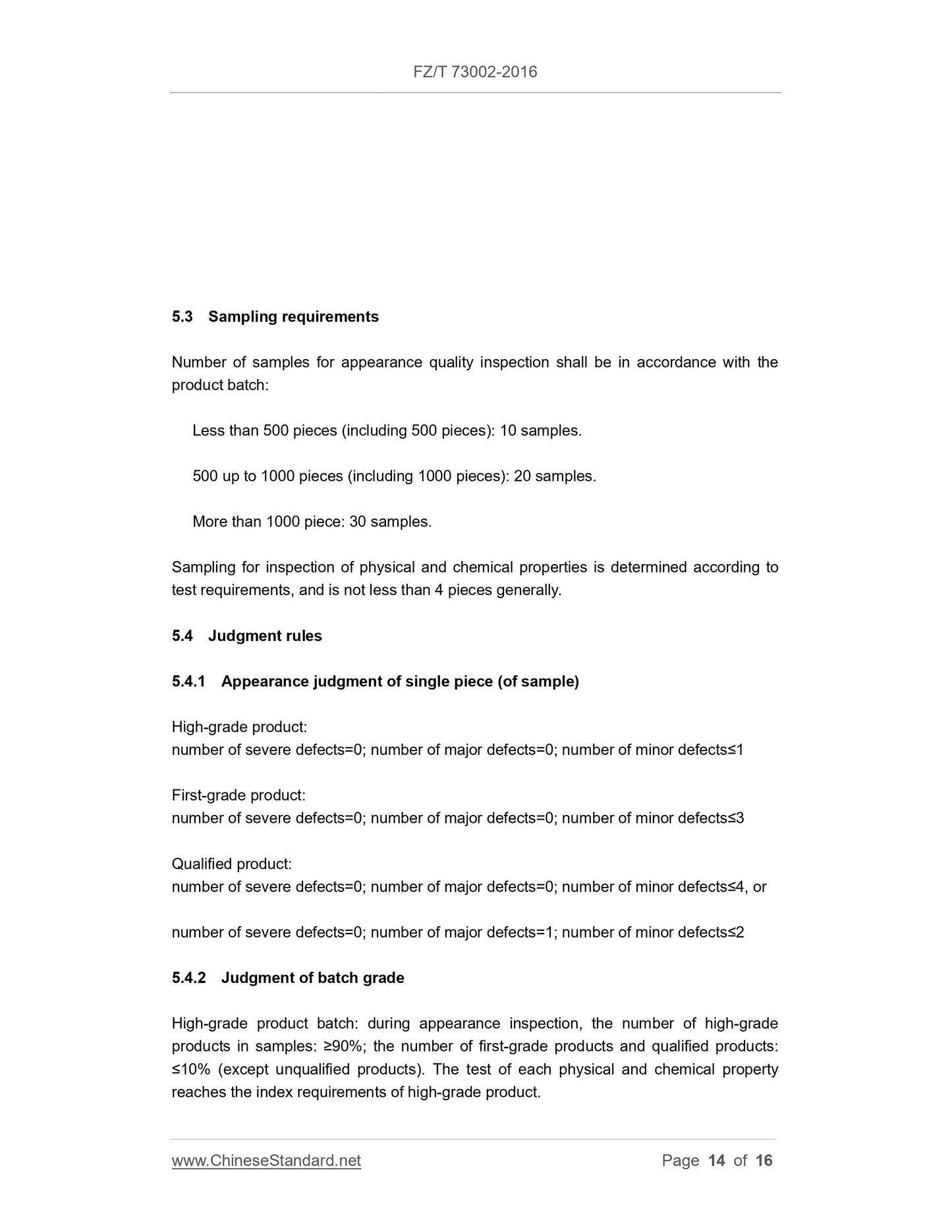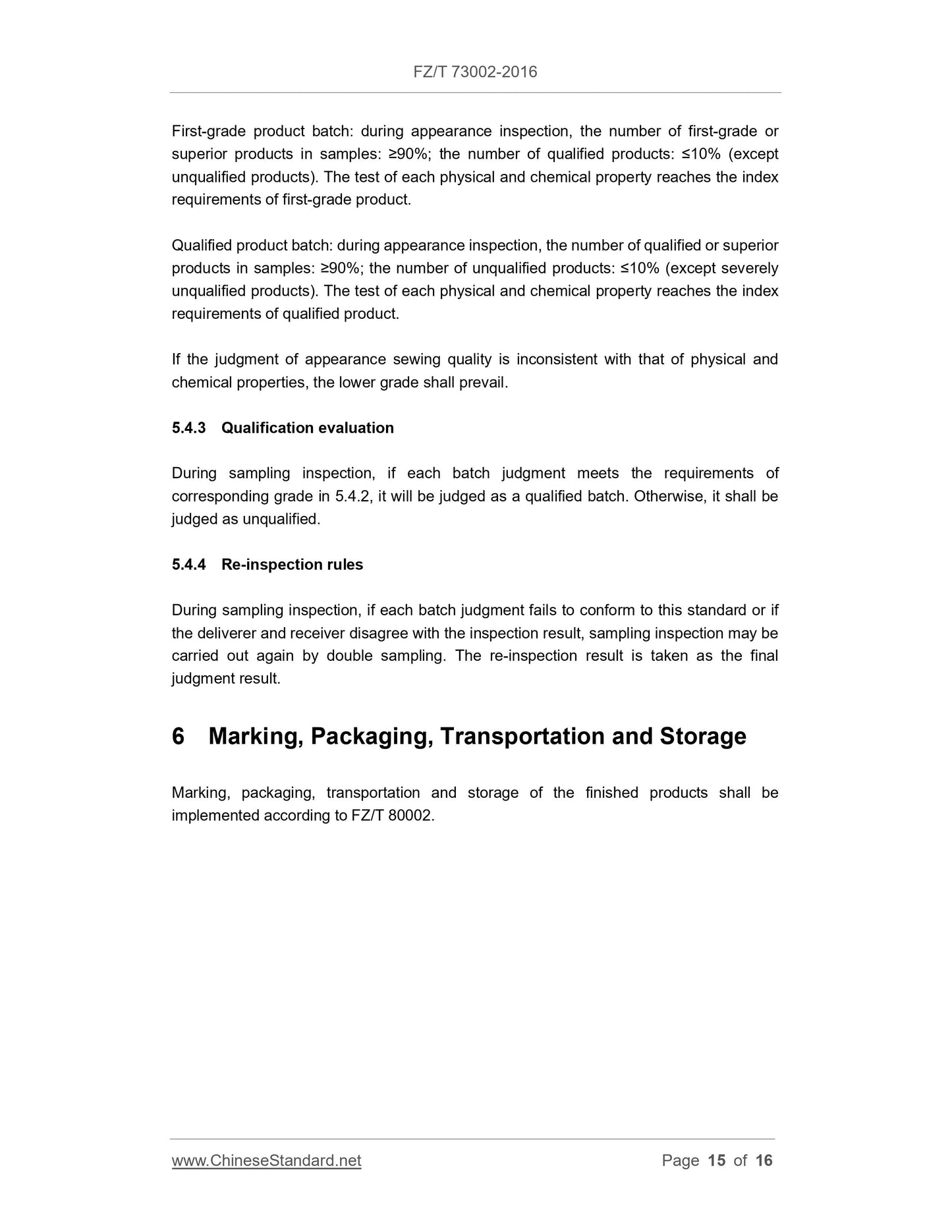PayPal, credit cards. Download editable-PDF and invoice in 1 second!
FZ/T 73002-2016 English PDF (FZT73002-2016)
FZ/T 73002-2016 English PDF (FZT73002-2016)
Precio habitual
$135.00 USD
Precio habitual
Precio de oferta
$135.00 USD
Precio unitario
/
por
Los gastos de envío se calculan en la pantalla de pago.
No se pudo cargar la disponibilidad de retiro
Delivery: 3 seconds. Download true-PDF + Invoice.
Get QUOTATION in 1-minute: Click FZ/T 73002-2016
Historical versions: FZ/T 73002-2016
Preview True-PDF (Reload/Scroll if blank)
FZ/T 73002-2016: Knitted caps
FZ/T 73002-2016
FZ
TEXTILE INDUSTRY STANDARD OF
THE PEOPLE’S REPUBLIC OF CHINA
ICS 59.080.30
W 63
Replacing FZ/T 73002-2006
Knitted Caps
针织帽
ISSUE ON: APRIL 5, 2016
IMPLEMENTED ON: SEPTEMBET 1, 2016
Issued by: Ministry of Industry and Information Technology of the
People's Republic of China
Table of Contents
Foreword ... 3
1 Scope ... 5
2 Normative References ... 5
3 Requirements ... 6
4 Inspection Methods ... 9
5 Inspection Rules ... 11
6 Marking, Packaging, Transportation and Storage ... 15
Annex A (Informative) Names of Product Defects ... 16
Knitted Caps
1 Scope
This standard specifies the requirements, inspection methods, inspection rules, marking,
packaging, transportation and storage of knitted caps.
This standard is applicable to caps with textile and knitted fabrics as main materials.
2 Normative References
The following referenced documents are indispensable for the application of this
document. For dated references, only the edition cited applies. For undated references,
the latest edition of the referenced document (including any amendments) applies.
GB/T 250 Textiles - Tests for Color Fastness - Grey Scale for Assessing
Change in Color
GB/T 3921-2008 Textiles - Tests for Color Fastness - Color Fastness to Soaping
GB/T 4841.3 Color Cards of Standard Depths for Dyeing with Dyestuffs 2/1, 1/3,
1/6, 1/12, 1/25
GB 5296.4 Instructions for Use of Products of Consumer Interest - Part 4:
Textiles and Apparel
GB/T 8427-2008 Textiles - Tests for Color Fastness - Color Fastness to Artificial Light:
Xenon Arc Fading Lamp Test
GB/T 8629-2001 Textiles - Domestic Washing and Drying Procedures for Textile
Testing
GB/T 8630 Textiles - Determination of Dimensional Change in Washing and
Drying
GB 18401 National General Safety Technical Code for Textile Products
GB/T 21294 Testing Methods of Physical and Chemical Performance of
Garments
GB/T 21295 Requirements of Physical and Chemical Performance of Garments
GB/T 24117 Knitted Fabrics - Description of Defects - Vocabulary
GB/T 29862 Textiles - Identification of Fiber Content
GB/T 33271 Woven Garments for Infants
4.4.3 Stretching resistance of non-detachable accessories shall be tested according to
GB/T 33271.
4.4.4 Test method for appearance quality after washing: assessment is carried out under
appearance testing conditions after washing and drying. Washing procedure is in
accordance with the requirements of GB/T 8630, and washing method is in accordance
with Procedure 7A (imitated hand washing is adopted for product marked with hand
washing); hang drying is adopted as the drying method. Dry cleaning procedure is in
accordance with the requirements of FZ/T 80007.3, and routine dry cleaning method is
adopted.
4.4.5 Other items of physical and chemical properties are tested according to GB/T
21294.
4.4.6 As for the test items with sampling parts not specified, samples may be taken from
finished products as required.
5 Inspection Rules
5.1 Inspection classification
5.1.1 Finished product inspection is classified into delivery inspection and type
inspection. Type inspection opportunity is specified according to actual manufacturer
situation or contractual agreement and generally carried out upon production transfer,
production recovery after shutdown and significant change of raw material or process.
5.1.2 Delivery inspection items shall meet the requirements of Chapter 3, except 3.5.
Delivery inspection rules of finished product shall meet the requirements of FZ/T 80004.
5.1.3 Type inspection items shall meet the requirements of Chapter 3.
5.2 Appearance quality grading and defect classification rules
5.2.1 Appearance quality grading
Appearance quality grading of the finished product shall be based on the existence and
severity of defect. Single product among samples shall be graded in terms of the number
and severity of defects; batch grade shall be determined based on the number and grade
of the single product among samples.
5.2.2 Appearance defect classification
5.3 Sampling requirements
Number of samples for appearance quality inspection shall be in accordance with the
product batch:
Less than 500 pieces (including 500 pieces): 10 samples.
500 up to 1000 pieces (including 1000 pieces): 20 samples.
More than 1000 piece: 30 samples.
Sampling for inspection of physical and chemical properties is determined according to
test requirements, and is not less than 4 pieces generally.
5.4 Judgment rules
5.4.1 Appearance judgment of single piece (of sample)
High-grade product:
number of severe defects=0; number of major defects=0; number of minor defects≤1
First-grade product:
number of severe defects=0; number of major defects=0; number of minor defects≤3
Qualified product:
number of severe defects=0; number of major defects=0; number of minor defects≤4, or
number of severe defects=0; number of major defects=1; number of minor defects≤2
5.4.2 Judgment of batch grade
High-grade product batch: during appearance inspection, the number of high-grade
products in samples: ≥90%; the number of first-grade products and qualified products:
≤10% (except unqualified products). The test of each physical and chemical property
reaches the index requirements of high-grade product.
First-grade product batch: during appearance inspection, the number of first-grade or
superior products in samples: ≥90%; the number of qualified products: ≤10% (except
unqualified products). The test of each physical and chemical property reaches the index
requirements of first-grade product.
Qualified product batch: during appearance inspection, the number of qualified or superior
products in samples: ≥90%; the number of unqualified products: ≤10% (except severely
unqualified products). The test of each physical and chemical property reaches the index
requirements of qualified product.
If the judgment of appearance sewing quality is inconsistent with that of physical and
chemical properties, the lower grade shall prevail.
5.4.3 Qualification evaluation
During sampling inspection, if each batch judgment meets the requirements of
corresponding grade in 5.4.2, it will be judged as a qualified batch. Otherwise, it shall be
judged as unqualified.
5.4.4 Re-inspection rules
During sampling inspection, if each batch judgment fails to conform to this standard or if
the deliverer and receiver disagree with the inspection result, sampling inspection may be
carried out again by double sampling. The re-inspection result is taken as the final
judgment result.
6 Marking, Packaging, Transportation and Storage
Marking, packaging, transportation and storage of the finished products shall be
implemented according to FZ/T 80002.
Get QUOTATION in 1-minute: Click FZ/T 73002-2016
Historical versions: FZ/T 73002-2016
Preview True-PDF (Reload/Scroll if blank)
FZ/T 73002-2016: Knitted caps
FZ/T 73002-2016
FZ
TEXTILE INDUSTRY STANDARD OF
THE PEOPLE’S REPUBLIC OF CHINA
ICS 59.080.30
W 63
Replacing FZ/T 73002-2006
Knitted Caps
针织帽
ISSUE ON: APRIL 5, 2016
IMPLEMENTED ON: SEPTEMBET 1, 2016
Issued by: Ministry of Industry and Information Technology of the
People's Republic of China
Table of Contents
Foreword ... 3
1 Scope ... 5
2 Normative References ... 5
3 Requirements ... 6
4 Inspection Methods ... 9
5 Inspection Rules ... 11
6 Marking, Packaging, Transportation and Storage ... 15
Annex A (Informative) Names of Product Defects ... 16
Knitted Caps
1 Scope
This standard specifies the requirements, inspection methods, inspection rules, marking,
packaging, transportation and storage of knitted caps.
This standard is applicable to caps with textile and knitted fabrics as main materials.
2 Normative References
The following referenced documents are indispensable for the application of this
document. For dated references, only the edition cited applies. For undated references,
the latest edition of the referenced document (including any amendments) applies.
GB/T 250 Textiles - Tests for Color Fastness - Grey Scale for Assessing
Change in Color
GB/T 3921-2008 Textiles - Tests for Color Fastness - Color Fastness to Soaping
GB/T 4841.3 Color Cards of Standard Depths for Dyeing with Dyestuffs 2/1, 1/3,
1/6, 1/12, 1/25
GB 5296.4 Instructions for Use of Products of Consumer Interest - Part 4:
Textiles and Apparel
GB/T 8427-2008 Textiles - Tests for Color Fastness - Color Fastness to Artificial Light:
Xenon Arc Fading Lamp Test
GB/T 8629-2001 Textiles - Domestic Washing and Drying Procedures for Textile
Testing
GB/T 8630 Textiles - Determination of Dimensional Change in Washing and
Drying
GB 18401 National General Safety Technical Code for Textile Products
GB/T 21294 Testing Methods of Physical and Chemical Performance of
Garments
GB/T 21295 Requirements of Physical and Chemical Performance of Garments
GB/T 24117 Knitted Fabrics - Description of Defects - Vocabulary
GB/T 29862 Textiles - Identification of Fiber Content
GB/T 33271 Woven Garments for Infants
4.4.3 Stretching resistance of non-detachable accessories shall be tested according to
GB/T 33271.
4.4.4 Test method for appearance quality after washing: assessment is carried out under
appearance testing conditions after washing and drying. Washing procedure is in
accordance with the requirements of GB/T 8630, and washing method is in accordance
with Procedure 7A (imitated hand washing is adopted for product marked with hand
washing); hang drying is adopted as the drying method. Dry cleaning procedure is in
accordance with the requirements of FZ/T 80007.3, and routine dry cleaning method is
adopted.
4.4.5 Other items of physical and chemical properties are tested according to GB/T
21294.
4.4.6 As for the test items with sampling parts not specified, samples may be taken from
finished products as required.
5 Inspection Rules
5.1 Inspection classification
5.1.1 Finished product inspection is classified into delivery inspection and type
inspection. Type inspection opportunity is specified according to actual manufacturer
situation or contractual agreement and generally carried out upon production transfer,
production recovery after shutdown and significant change of raw material or process.
5.1.2 Delivery inspection items shall meet the requirements of Chapter 3, except 3.5.
Delivery inspection rules of finished product shall meet the requirements of FZ/T 80004.
5.1.3 Type inspection items shall meet the requirements of Chapter 3.
5.2 Appearance quality grading and defect classification rules
5.2.1 Appearance quality grading
Appearance quality grading of the finished product shall be based on the existence and
severity of defect. Single product among samples shall be graded in terms of the number
and severity of defects; batch grade shall be determined based on the number and grade
of the single product among samples.
5.2.2 Appearance defect classification
5.3 Sampling requirements
Number of samples for appearance quality inspection shall be in accordance with the
product batch:
Less than 500 pieces (including 500 pieces): 10 samples.
500 up to 1000 pieces (including 1000 pieces): 20 samples.
More than 1000 piece: 30 samples.
Sampling for inspection of physical and chemical properties is determined according to
test requirements, and is not less than 4 pieces generally.
5.4 Judgment rules
5.4.1 Appearance judgment of single piece (of sample)
High-grade product:
number of severe defects=0; number of major defects=0; number of minor defects≤1
First-grade product:
number of severe defects=0; number of major defects=0; number of minor defects≤3
Qualified product:
number of severe defects=0; number of major defects=0; number of minor defects≤4, or
number of severe defects=0; number of major defects=1; number of minor defects≤2
5.4.2 Judgment of batch grade
High-grade product batch: during appearance inspection, the number of high-grade
products in samples: ≥90%; the number of first-grade products and qualified products:
≤10% (except unqualified products). The test of each physical and chemical property
reaches the index requirements of high-grade product.
First-grade product batch: during appearance inspection, the number of first-grade or
superior products in samples: ≥90%; the number of qualified products: ≤10% (except
unqualified products). The test of each physical and chemical property reaches the index
requirements of first-grade product.
Qualified product batch: during appearance inspection, the number of qualified or superior
products in samples: ≥90%; the number of unqualified products: ≤10% (except severely
unqualified products). The test of each physical and chemical property reaches the index
requirements of qualified product.
If the judgment of appearance sewing quality is inconsistent with that of physical and
chemical properties, the lower grade shall prevail.
5.4.3 Qualification evaluation
During sampling inspection, if each batch judgment meets the requirements of
corresponding grade in 5.4.2, it will be judged as a qualified batch. Otherwise, it shall be
judged as unqualified.
5.4.4 Re-inspection rules
During sampling inspection, if each batch judgment fails to conform to this standard or if
the deliverer and receiver disagree with the inspection result, sampling inspection may be
carried out again by double sampling. The re-inspection result is taken as the final
judgment result.
6 Marking, Packaging, Transportation and Storage
Marking, packaging, transportation and storage of the finished products shall be
implemented according to FZ/T 80002.
Share
